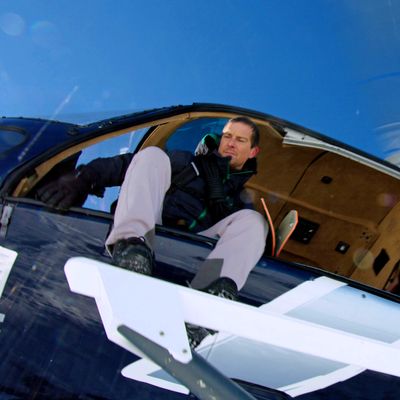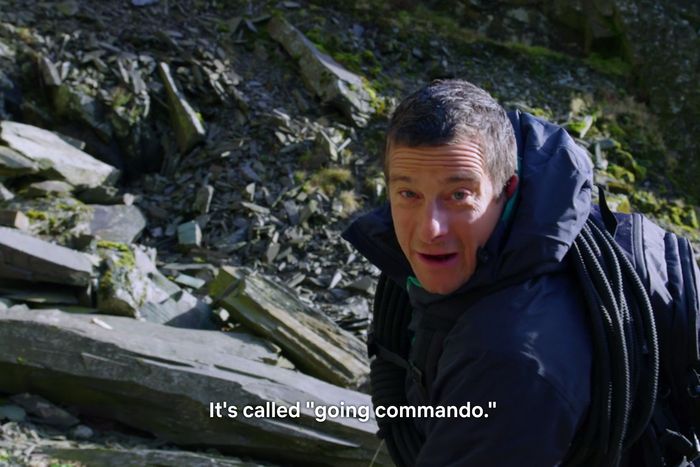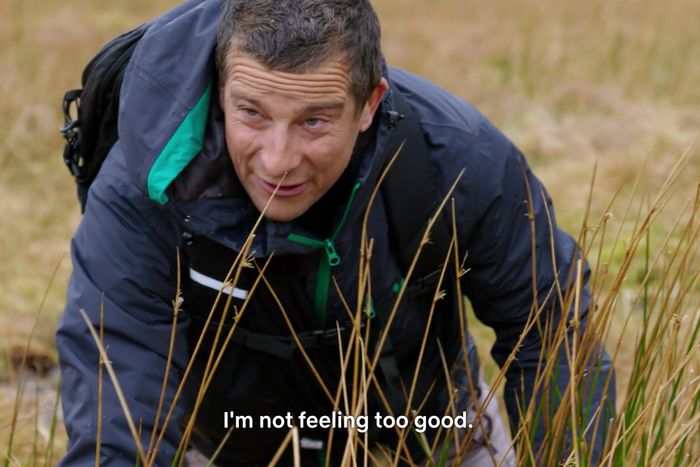
Netflix’s new interactive show You vs. Wild asks you, the viewer, to choose how adventure survivalist Bear Grylls will make it out of the wilderness alive. Stay warm by running, or stop and build a fire? Eat gorse flowers for energy, or snack on some raw bird eggs? Do a front flip or a back flip off of a helicopter into a frigid lake?
Okay, while that last choice seems to mostly demonstrate that Bear Grylls can do both a front and a back flip, it’s a decent stand-in for You vs. Wild’s overall tone: Death-defying scenarios … but goofy fun!
Making the show involved an unusual combination of reality-television storytelling and highly controlled, scripted scenarios. You vs. Wild producer and long-time Bear Grylls collaborator Rob Buchta talked to Vulture about how the show was made, whether Grylls actually got poisoned while making the show, and how producing a guy like him is “like trying to ride a bull.”
How long did it take to shoot these eight episodes?
It was months and months of pre-production. Basically, Bear would send us to places he thought would be interesting for adventures. And then we shot for about five days per episode. There’s a couple two-parters in there, but they were each five days per part.
It was a lot of improvisation. The thing I would say it’s most akin to is Curb Your Enthusiasm. We’ve got a talent who shows up in a sandbox we’ve prepared, and he improvises his way through everything. I’ve worked with Bear for five years now, and that’s his thing. You give him a sandbox and then launch him.
The way this show works, Bear has to do different versions of the same thing. So there’s a sandbox, but then you also have to intervene to do multiple versions, right? How did you decide when to intervene?
Basically we’d be like, “All right, Bear, you’ve got to get across this river. What are two ways you could do that?” And he’d be like, “I could try to swing across on this vine, or I could try to balance on the log and get across.” He’d know in his mind which was the better bet, the safer bet, but we’d let the viewer play with him a little bit, almost like he was their action figure. He’d do both, and then once he would do one, we had a change of clothes if he needed for continuity. We were straddling the unscripted and scripted worlds in a way I’ve never done before.
What I meant by the improvisation was, whether Bear fell off the log or not, or whether he made it across on the vine, we didn’t know which way was going to be right and which was going to be wrong until after he did it. So then we’d say, “Okay, that worked, so this moves us on to the next obstacle.” Or, “Shoot, that really screwed up. This is a dead end for the viewer.”
There are some circumstances where both options work. You always get funneled onto the frozen lake, for instance. But once you’re on the frozen lake, he knows he’s probably going to fall through it unless he crawls, right?
We knew you should probably not go out on that ice. Bear was like, “If you crawled, you’d be alright, but I wouldn’t walk across it.” And we were like, “In this case, Bear, the viewer is making a mistake.” So he walked across it and eventually, sure enough, he fell through.
Then what happens? Because on the show, he hauls himself out of the lake and the episode ends. He was really in that lake, wasn’t he? How dangerous is that? Do producers swarm him and warm him up as soon as he gets out?
Bear’s tough. If you remember him from his Man vs. Wild days, you’ve seen him jump into things like that naked, with no editing. So yeah, he fell in the ice. He pulled himself up out of there. What he actually did was he stripped down, because his clothes were soaking wet, and started rolling in the snow to get the wet stuff off of him.
Sorry, the immediate aftermath is him naked and rolling in the snow?
Correct. The cameramen stopped because they had to change batteries, and they needed a break because those cameras weigh 40 pounds. I was like, “Aw man, we should be filming this!” But it was too late to capture it. And it was for Netflix Kids, so I didn’t know how they’d feel about naked Bear Grylls.
But of course we have blankets, and we have a medic standing by in case he gets himself in real trouble. The medic would come over with a blanket and give him some hot water and things. Because the fact is, you’re out there too long, you’re gonna get hypothermia. Obviously we’re not gonna let that happen, because we’ve gotta move on and shoot the next scene.
For the episodes that have more of a story frame, like the one where he has to rescue the dog, how much did Bear know going in? Did he know where the dog was going to be, or did he figure that out in real time?
It’s this weird straddling of the two, right? Obviously the dog wasn’t really stranded. We created that sandbox for Bear to play in. Bear didn’t know where the dog was, so we as the producers tried to stay one step ahead of Bear. It’s much easier for him to improvise if there is some uncertainty. As we put obstacles in front of him, we’d say, “What are two ways you could do this?” And off he’d go.
Was a producer out there putting dog prints in the ice?
No, no, the dog prints were real. I don’t want to pull back the curtain too much, but obviously we had to have the dog walk to leave prints.
I’m sure viewers would be happy to know that the dog was not actually out there for 36 hours waiting to be rescued by Bear Grylls.
Right. There’s a disclaimer — Netflix has kind of buried it, but if you click on “view credits” at the end, there is a disclaimer that says we have created scenarios. For example, the doctor in Panama isn’t really a doctor, she’s essentially an actress for this. But the goal was to give you an idea of, “What would Bear Grylls do?”
What about the parts where he has to choose between two things to eat? He seems to actually eat the bad mushroom, and also the raw bird eggs. Did he find those and say, “Should I eat these?” How did that work?
Those raw eggs are everywhere in the terrain. We needed to make sure there was a choice, so we would maybe move the eggs to where we needed them. But yeah, he’d really eat them. A lot of times that will make you sick. So he, I would say, “demonstrated” what would happen if you got sick.
This makes me feel better, because I poisoned him several times over the course of watching the show.
Without getting into specifics, poor Bear has gotten sick on our shoots. Many times.
From ingesting stuff like those eggs?
From various things, yeah. And this is over the course of working with him for five years. We always try not to let it happen, but trying to control Bear is like trying to ride a bull. I try to keep him within the guardrails as best I can. He will improvise, he will go off script, and sometimes it backfires on him. We’ve had to shut down production because of it. He’s been sick and vomiting from stuff he’s done to demonstrate survival things.
The most grisly bit I found in You vs. Wild is the part where he has to choose between two cactuses to get water, and I made him pick the poisonous one. Please tell me his hands weren’t actually covered in terrible blisters?
I don’t want to spoil it for the viewer. Let me just say, part of the game is you making bad decisions, and some of those decisions, it’s almost a human rights issue. We’re not gonna…
You can’t torture the lead of the show on purpose.
Right. But that being said, it’s a simulation. So we do want to simulate what would happen if you touched that milky substance.
It did not look good.
Correct.
You’re out there for five days shooting one of these stories. What are the most challenging moments?
You see Bear in some pretty precarious situations, and the biggest challenge is keeping the crew safe. We’re really striving to pick up the visuals a notch, with specialty cameras and drones, and it required more people. Frankly, we’re not as good in the wild as Bear is.
You’re not Bear Grylls.
Exactly. So how do we make sure we’re keeping up with Bear in this crazy terrain while making sure we’re not getting hurt? Luckily, Bear has a core group of safety people who’ve done every show with him since the very beginning. They’re all ex-military, some of them have submitted Everest several times. So they make sure the crew doesn’t get hurt.
Which scenarios are the most treacherous?
We’d be negligent if we didn’t mitigate risk, so we always find a way to keep us safe. But, for example, if Bear comes down a 200-foot cliff and we’re filming him from the bottom, that means the crew also has to rappel down that 200-foot cliff. The crew is very small. We have two camera guys, a sound guy, a drone operator, and myself. And a couple safety people as needed — sometimes the safety team to crew member ratio is one-to-one.
I wondered about the scenes with animals — the wolf, the jaguar, the memorable bit with a sheep. I assume they required finding an animal and making sure it was in the right place at the right time?
Anyone who’s watching that discerningly can make their own assumptions. What I’ll say is, sometimes it happens naturally, and sometimes we have to push it along a bit.
I was quite surprised when he ended up wrestling a crocodile.
Believe it or not, I’ve filmed him doing that a bunch of times. Running into a crocodile in Panama is like running into a squirrel in Central Park.
Bear seems to helicopter out before anything truly terrible happens. How did you decide where to draw the line when showing the consequences of each choice?
It’s a combination of Bear and the medics’ judgment call. You could make this show as extreme as you want to, and it could be very dangerous for the host. You could kill the host if you wanted to. We just had to draw that line. When Bear told us, for instance, “If I was really out here, I would figure out a way to start a fire, and I would likely survive. But do we really want to film for the next three hours, me freezing and hopefully starting a fire?” Also, with Netflix, we didn’t want to depict Bear failing mortally. We didn’t want to scare kids. So rescue by helicopter was always an option. When we get to that line when we’d ask Bear if he had any options left, he’d say, “Not really, dude.” And we’d say, “cool, let’s film a rescue sequence.”
It must cost a lot to insure him?
Ha, I assume so, but I actually don’t know. That’s an even bigger issue on Running Wild, when we’re taking celebrities out.
Do you want to make more episodes of this show? As you were filming it, were you thinking about other scenarios to try?
Totally. It was a real challenge, and there were times when I was pining for the days of the simple, linear, unscripted TV show producing. That being said, I really liked the challenge and I’d love to do more. There are so many places in the world were we could take Bear.
Did Bear end up liking the multiple versions? It feels like it could cramp his improvisational style.
He’s a father of three teenage boys, and I think he was seeing it through his boys’ eyes. Before the greenlight on this show, when I was talking with Bear about doing this idea and got him on board, I think that was the thing. Dude, this will be so fun to pick what you do. We’d never imagined it before because the technology didn’t exist, but as soon as Netflix started doing these choose-your-own-path shows, we were like, “Oh my God, we could do that with Bear.” We knew it’d be a lot of hard work, we knew it’d be a challenge, but we didn’t care.
Will Bear be out in the wilderness doing stuff like this when he’s 70?
I don’t know. Am I going to be doing this when I’m 70? Are you going to be doing this when you’re 70?
Well, my job doesn’t involve falling into a frozen lake.
That’s true. It’s probably like pro sports, right? The fans and the stats will tell you when you’re too old for this shit. I don’t see him ever not doing it until it’s just not an option for him. He loves it so much. You get him out in the wild, he just comes alive.




